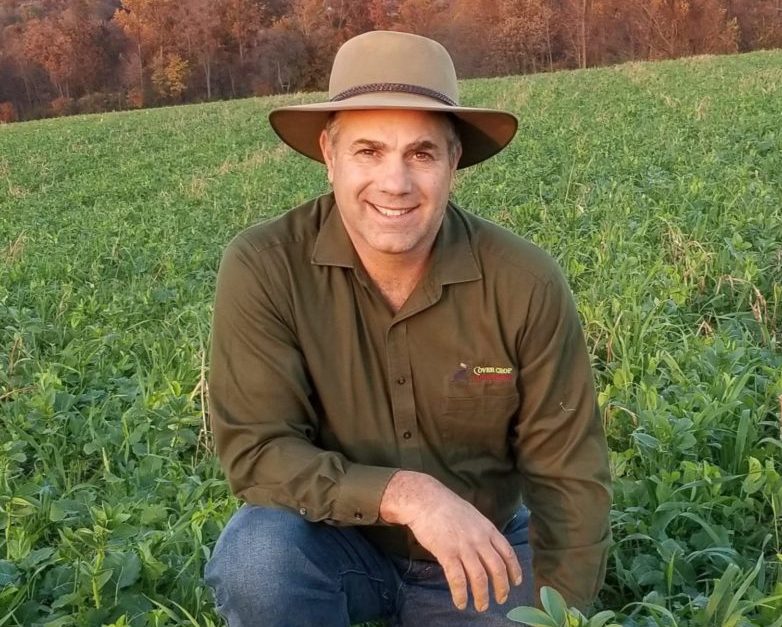Cover crops are one of the most widely discussed practices in agriculture today. Touting benefits like improved organic matter and water holding capacity in soil — and heightened performance of cash crops — they seem to offer a fair amount of promise.
But those benefits are only as good as farmers’ willingness to buy into the cover crop craze.
“If you look at the past 15 years, we have come a long way. The acreages are increasing slowly,” Steve Groff tells AFN from his 200-acre farm in Southeast Pennsylvania.
“Now, every farmer has pretty much heard about cover crops. Farmers are primed like never before to use them.”
Groff has been farming since he graduated high school in 1982, and today produces vegetables for buyers including Whole Foods and restaurant chain Sweetgreen. His early days included over 11 years of research involving cover crops. During the first four of those years, he didn’t see much difference to his business. But when a severe drought hit in 1999, the acreage where he planted cover crops yielded 28 more bushels of corn on average compared to his other fields.
This sparked Groff’s commitment to educating growers about the benefits of cover crops and exploring how to maximize their benefits. He speaks, writes, and teaches about cover crops, and has a new book coming out in September called ‘The Future-Proof Farm: Changing Mindsets in a Changing World.’ He’s gone from a cover crop cheerleader to a cover crop coach, he says.
Between 2012 and 2017, cover crop planting increased by 5 million acres, reaching 15 million acres in total according to the US Department of Agriculture’s 2017 Census of Agriculture. Iowa, Arizona, Illinois, Missouri, Mississippi, Nebraska, Vermont, and Ohio led the US in terms of increased cover crop plantings.
“The subtitle of my book is: ‘changing mindsets in a changing world.’ There are some different mindsets out there,” Groff says. “On the extreme end, some say that a farm will never adopt cover crops until there’s a generational change.”
Barriers to cover cropping
Adopting an advanced cover cropping program is no small task. With differences in soil and weather, variables around the particular cash crops that a farmer is producing, and the overwhelming amount of information online and elsewhere, it’s hard to know where to start.
“Becoming a serious cover cropper is like going from a nurse to a surgeon,” Groff says.
Practical barriers beyond education include a lack of access to land. A landlord may have different ideas about how his or her land should be used than the farmer renting it. Cover crops are a long-term investment, Groff adds, making a lease a risky place to start sowing seeds of change that won’t manifest for years to come.
But “if you commit for 10 years with effective management they will pay,” he says. “I’m not going to tell you that cover crops pay every year. Sometimes it’s just bad luck with weather, or rookie mistakes about what species to plant, or knowing when to terminate. But when you are five to seven years in, generally very few people abandon the philosophy of cover crops.”
For many farmers, the education, investment, and legwork are indeed paying off. In Cotton Plant, Arkansas, brothers Adam and Seth Chappell have turned their 8,000-acre farm into a cover crop paradise. Five years ago, they were spending $100 per acre just to manage invasive, herbicide-resistant Palmer amaranth. Today, they grow a rotation of non-GMO corn, cotton, soybeans, and rice while no-tilling fields and planting every acre in cover crops.
Still, 10 years can seem like an eternity considering the financial and physical effort that goes into adding a cover crop program to an existing operation. When met with opposition to the decade-long timeline, Groff simply encourages farmers to treat their cover crops like they treat their cash crops. This means ordering seeds in advance and having planting equipment ready well before the prime cover crop planting window may open.
Even finding ways to incorporate cover cropping into an existing planting or harvesting routine can make a difference while providing opportunities for younger generations to get involved, he says.
Innovation around cover crops
A number of agrifoodtech companies are working on innovations around cover cropping. St Louis-based CoverCress is developing what it calls a ‘winter cash cover crop‘ from pennycress through plant breeding and new genome editing tools. The resulting crop is crushed, creating oil and a residual feed-grade meal product that can be marketed to livestock producers.
Massachusetts’ Yield10 Bioscience is developing a gene-edited winter cover crop alternative to wheat for growers in the Pacific Northwest based on camelina.
Agrisoma Biosciences is developing a cover crop out of carinata, a member of the mustard family. In 2018, the Canadian startup partnered with United Airlines and French oil and proteins company Avril Group to accomplish the second international commercial flight using the company’s seed oil.




